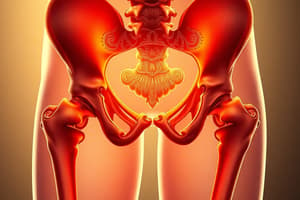Podcast
Questions and Answers
What symptom is commonly associated with Femoro-Acetabular Impingement (FAI)?
What symptom is commonly associated with Femoro-Acetabular Impingement (FAI)?
- Dull deep pain in the anterior hip or groin area (correct)
- Excessive range of motion in the hip
- Sharp pain in the shoulder
- Swelling in the shoulder joint
Which of the following best describes the pathophysiology of Femoro-Acetabular Impingement?
Which of the following best describes the pathophysiology of Femoro-Acetabular Impingement?
- Premature contact between the acetabulum and proximal femur (correct)
- Complete dislocation of the femur
- Overextension of the shoulder joint
- Hypertrophy of shoulder musculature
Tenderness on palpation is observed in which condition?
Tenderness on palpation is observed in which condition?
- Shoulder dislocation
- Rotator cuff tear
- Fractured humerus
- Femoro-Acetabular Impingement (FAI) (correct)
What does 'AROM' refer to in the context of shoulder and hip assessments?
What does 'AROM' refer to in the context of shoulder and hip assessments?
In which area would you expect a patient with FAI to report pain?
In which area would you expect a patient with FAI to report pain?
What is a characteristic feature of shoulder dislocation?
What is a characteristic feature of shoulder dislocation?
What is the primary cause of pain in femoro-acetabular impingement?
What is the primary cause of pain in femoro-acetabular impingement?
Which of the following describes Cam morphology?
Which of the following describes Cam morphology?
Which of the following symptoms may be associated with femoro-acetabular impingement?
Which of the following symptoms may be associated with femoro-acetabular impingement?
What is the main characteristic of pincer morphology?
What is the main characteristic of pincer morphology?
Which activities could potentially cause impingement in femoro-acetabular dysplasia?
Which activities could potentially cause impingement in femoro-acetabular dysplasia?
What impact does a hip movement disorder have on the morphology of the hip?
What impact does a hip movement disorder have on the morphology of the hip?
Chronic hip impingement may lead to which consequence if not addressed?
Chronic hip impingement may lead to which consequence if not addressed?
Which of the following is a common misconception regarding femoro-acetabular impingement symptoms?
Which of the following is a common misconception regarding femoro-acetabular impingement symptoms?
Which clinical sign is indicative of adductor-related groin pain?
Which clinical sign is indicative of adductor-related groin pain?
What is a characteristic of iliopsoas-related groin pain?
What is a characteristic of iliopsoas-related groin pain?
Inguinal-related groin pain is characterized by which of the following?
Inguinal-related groin pain is characterized by which of the following?
What symptom is not associated with iliopsoas-related groin pain?
What symptom is not associated with iliopsoas-related groin pain?
Which of the following best describes the testing procedures for adductor-related clinical patterns?
Which of the following best describes the testing procedures for adductor-related clinical patterns?
Which is a common symptom of groin pain related to the adductor muscle?
Which is a common symptom of groin pain related to the adductor muscle?
Study Notes
Orthopedic Examination (OE)
- Cluster of symptoms includes O'briens test, crank test, and biceps load II.
- Active Range of Motion (AROM) remains largely intact.
- Tenderness observed upon palpation of the affected area.
Femoro-Acetabular Impingement (FAI)
- Characterized by symptomatic premature contact between acetabulum and proximal femur.
- Patients may report a dull deep pain in the anterior hip or groin area.
- Hip morphology can cause a movement disorder, leading to painful contact between femur and acetabulum due to abnormal anatomy.
- Clinically recognized types:
- Cam morphology: identifiable bony bump at femoral head-neck junction.
- Pincer morphology: over-coverage of acetabulum or femoral retroversion.
- Mixed morphology: presence of both cam and pincer characteristics.
- Symptoms may include joint locking, clicking, or catching sensations during movement.
- Activities that exacerbate impingement symptoms should be noted; specific movements may provoke pain.
- Positive pain provocation with FABER (Flexion, ABduction, External Rotation) and Ober's tests signal underlying issues.
Groin Pain
- Adductor-related groin pain characterized by tenderness and discomfort during resisted strength testing (RSC) of adductors.
- Iliopsoas-related pain is assessed through hip flexion resistance and noted during the Thomas test.
- Inguinal-related pain presents as tenderness in the inguinal canal region with no visible palpable hernia.
Studying That Suits You
Use AI to generate personalized quizzes and flashcards to suit your learning preferences.
Related Documents
Description
This quiz focuses on the clinical aspects of orthopedic examinations and femoro-acetabular impingement (FAI). You will explore the symptoms, diagnostic tests, and types of FAI morphology, including cam, pincer, and mixed types. Test your knowledge on the implications of AROM and the associated movement disorders.



